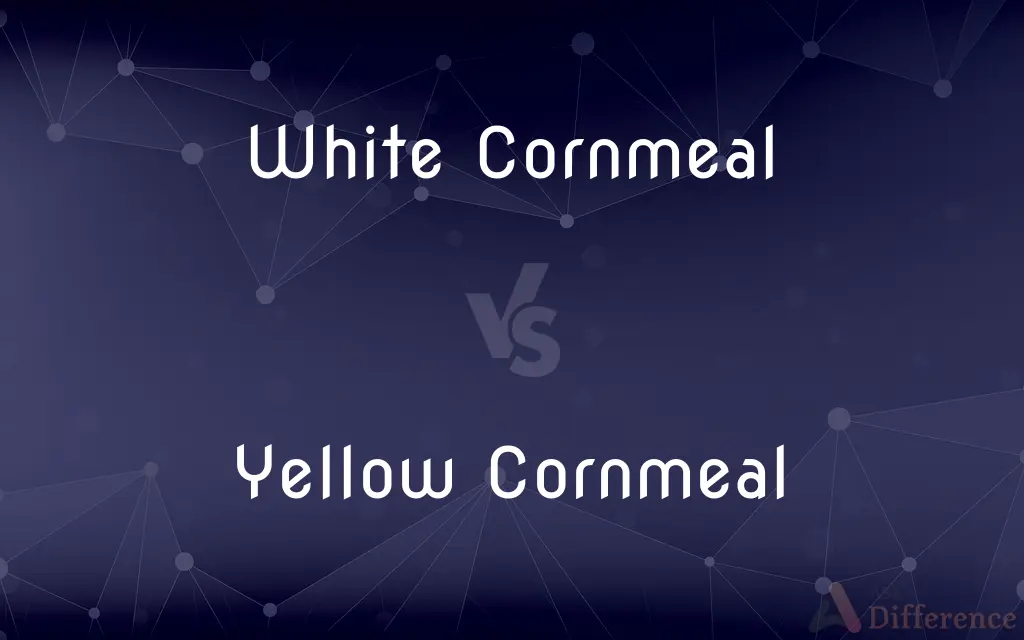White Cornmeal vs. Yellow Cornmeal — What's the Difference?
Edited by Tayyaba Rehman — By Maham Liaqat — Published on March 3, 2024
White cornmeal is made from white corn, offering a sweeter, milder flavor, while yellow cornmeal, from yellow corn, has a more robust taste, influencing culinary uses.

Difference Between White Cornmeal and Yellow Cornmeal
Table of Contents
ADVERTISEMENT
Key Differences
White cornmeal and yellow cornmeal are both ground forms of dried corn, differing mainly in the type of corn used. White cornmeal comes from white corn, known for its sweet and subtle flavor, making it a preferred choice in certain baked goods and cereals. Yellow cornmeal, derived from yellow corn, has a stronger, more pronounced corn flavor, often used in heartier recipes like cornbread and polenta.
The nutritional profiles of white and yellow cornmeal are similar, providing carbohydrates, fiber, and essential nutrients, though yellow cornmeal contains more beta-carotene, giving it a slightly higher vitamin A content. This difference is due to the pigment in the yellow corn kernels.
In terms of culinary use, white cornmeal is often favored in recipes requiring a delicate flavor, such as cakes and pastries, or in specific regional cuisines that traditionally use white corn. Yellow cornmeal, with its robust flavor, is preferred for creating more rustic dishes that highlight the corn taste, such as Southern-style cornbread or Italian polenta.
Texture-wise, both white and yellow cornmeal can range from finely ground to coarse, affecting the dish's texture. Finely ground cornmeal results in a softer, smoother texture in recipes, while coarse cornmeal provides a heartier, more rustic feel.
The choice between white and yellow cornmeal depends on personal preference and the specific requirements of the recipe being prepared. Both types offer versatility and a rich corn flavor that enhances a variety of dishes.
ADVERTISEMENT
Comparison Chart
Corn Type
Made from white corn
Made from yellow corn
Flavor
Sweeter, milder
Stronger, more pronounced
Nutritional Content
Similar in carbs and fiber, slightly less beta-carotene
Contains more beta-carotene, slightly higher in vitamin A
Culinary Uses
Preferred in delicate dishes, cakes, pastries
Used in hearty recipes, cornbread, polenta
Texture Options
Available in fine to coarse grinds
Available in fine to coarse grinds
Compare with Definitions
White Cornmeal
Ground white corn with a sweet, subtle flavor.
I used white cornmeal for the muffins to keep them light in taste.
Yellow Cornmeal
Made from ground yellow corn, known for its bold flavor.
Yellow cornmeal adds a rich corn taste to the recipe.
White Cornmeal
Offers a versatile texture from fine to coarse.
For a smoother pudding, choose fine-ground white cornmeal.
Yellow Cornmeal
Available in various textures, from fine to coarse.
Choose coarse yellow cornmeal for a hearty, rustic texture.
White Cornmeal
Often chosen for its lighter color in recipes.
White cornmeal keeps the pancakes a lovely light color.
Yellow Cornmeal
Preferred for recipes requiring a pronounced corn flavor.
Yellow cornmeal enhances the savory notes of the dish.
White Cornmeal
Less common in robust, hearty dishes.
White cornmeal gives a tender crumb to cornbread.
Yellow Cornmeal
Contains slightly more nutrients due to beta-carotene.
Opt for yellow cornmeal for a vitamin A boost in your diet.
White Cornmeal
Ideal for delicate baked goods and specific regional dishes.
White cornmeal is a staple in my Southern baking recipes.
Yellow Cornmeal
A staple for hearty dishes like cornbread and polenta.
For authentic Italian polenta, always use coarse yellow cornmeal.
Common Curiosities
Why choose white cornmeal over yellow?
White cornmeal is chosen for its milder flavor and lighter color, ideal for delicate dishes and pastries.
Can white and yellow cornmeal be used interchangeably?
Yes, they can be used interchangeably in most recipes, though the final dish's flavor and color may vary.
Can I use yellow cornmeal in baking?
Absolutely, yellow cornmeal is often used in baking, especially for recipes that benefit from its robust flavor.
Is there a nutritional difference between white and yellow cornmeal?
The differences are minor, with yellow cornmeal having slightly more beta-carotene and vitamin A.
How does the grind of cornmeal affect recipes?
Finer grinds result in a softer texture, while coarser grinds add a rustic, hearty quality to dishes.
Does the color of cornmeal affect its use in recipes?
The color can affect the visual appearance of the dish but doesn't significantly impact most recipes' outcomes.
Why does yellow cornmeal have more vitamin A?
The beta-carotene, which converts to vitamin A in the body, gives yellow cornmeal its color and nutritional boost.
Is one type of cornmeal healthier than the other?
Both are healthy, whole-grain options, with yellow cornmeal offering a slight edge in vitamin A content.
How should I store cornmeal?
Store it in an airtight container in a cool, dry place, or refrigerate it to extend its shelf life.
What dishes are best made with white cornmeal?
Delicate cakes, pastries, and some traditional Southern and Latin American dishes.
Can I make polenta with white cornmeal?
Yes, while yellow cornmeal is traditional, white cornmeal can also be used to make polenta.
What's the best cornmeal for making cornbread?
It depends on personal preference and regional traditions; both white and yellow cornmeal can make delicious cornbread.
Is cornmeal gluten-free?
Yes, cornmeal is naturally gluten-free, making it a good choice for those with gluten sensitivities.
Can cornmeal go bad?
Yes, cornmeal can spoil or become rancid over time, especially if not stored properly in a cool, dry place.
Is there a taste difference between white and yellow cornmeal?
Yes, white cornmeal is generally milder and sweeter, while yellow cornmeal has a stronger, more pronounced corn flavor.
Share Your Discovery

Previous Comparison
Chancellor vs. Vice Chancellor
Next Comparison
Economic Profit vs. Normal ProfitAuthor Spotlight
Written by
Maham LiaqatEdited by
Tayyaba RehmanTayyaba Rehman is a distinguished writer, currently serving as a primary contributor to askdifference.com. As a researcher in semantics and etymology, Tayyaba's passion for the complexity of languages and their distinctions has found a perfect home on the platform. Tayyaba delves into the intricacies of language, distinguishing between commonly confused words and phrases, thereby providing clarity for readers worldwide.
















































